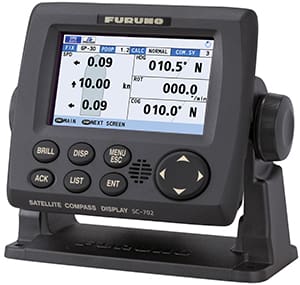Furuno recently released a new version of a product that shows how far GPS has come as a tool for mariners. The Furuno SC-70 satellite compass is an impressive product that provides capability that was once only possible if you had a ship and a big Sperry gyrocompass.
Way back at the beginning of GPS in the 1980s, the idea of a satellite navigation system that provided 1) continuous fix positions at 2) high accuracy (the Navy’s Transit satnav system couldn’t provide either) seemed an amazing prospect, even if early GPS use required a receiver the size of a garden shed.
Eventually GPS receivers became smaller, much more accurate and much less expensive. Many products became augmented with built-in GPS. As the technology evolved, GPS was used for things other than just position fixing.
One of those was something called a “GPS compass.” This uses two or more GPS antennas located a short distance apart — usually in a one-piece antenna enclosure. Based on the difference between the input from these antennas, the GPS compass can determine your heading like a magnetic compass or a mechanical gyrocompass would but with much greater accuracy. GPS compasses have been around for years now, but this latest Furuno unit has incredible specs and capabilities, and it is a true satellite compass because it can use signals from GPS, the European version of GPS called Galileo and the Russian system GLONASS. It does all this in a small package with a big display, plus a one-piece lozenge antenna.
The SC-70 compass provides precise satellite position, course over ground (COG) and speed over ground (SOG). But it also provides some big ship data like rate of turn (ROT) and three-axis speed (bow, stern and longitudinal). This capable little unit could be the ultimate satellite compass for any vessel short of very large crude carrier.

